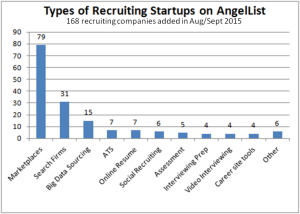Several times a week I get asked if I’ve heard of some new recruiting startup, and I jokingly respond that there is new one started daily and it is impossible to keep track. Well, it turns out I was off by a factor of about three. There are 2800 companies that are tagged as Recruiting Startups on AngelList , of which 199 were added in August and September 2015. I decided to take a look at each of these recently added companies to see what trends can be gleaned from them. After ignoring 31 firms that weren’t really recruiting-related, here is what I found about the remaining 168 companies – so almost three per day.

1. Is recruiting broken?
One theme I saw consistently in either the company description or on their website is some form of the statement “recruiting is broken” and their mission is to either reinvent how companies and candidates find each other or improve the process. Inefficiency and friction plague end-to-end recruiting. Companies are trying new methods to match candidates with companies like having candidates bid on being able to apply to a company or a tool for candidates to supply a form for recruiters to complete about the role before being allowed to contacting them. Who knows if any of these companies will truly reinvent talent acquisition, but at least there are many that claim to be trying.
2. Niche marketplaces are very popular
Nearly half (80) new companies reviewed are trying to bring recruiters and candidates together more effectively. In particular, niche market places for any type of narrow market you can identify is being created. Examples include two marketplaces for the cannabis industry: Hemployed and Greenseek; hyper-local job boards and sites for professional specialists to connect like healthcare and cyber security experts. For any marketplace, the challenge to is to get enough traction with both job posters and candidates to have a reasonable size marketplace and achieve some level of network effects. If nothing else, each of these sites should at least appear in the top 3 organic search results for ‘{name of the niche + jobs}’.
3. Big data is a big deal for sourcing candidates
Fifteen different companies using some form of big data and secret sauce algorithms to find the right match for your job. Terms like AI, machine learning and predictive analytics showed up several times. Each of these companies claim to be able to look at resumes, LinkedIn, Twitter, GitHub and other social sites and crunch all the data and then be able to spit out the winning candidates using their magical secret sauce tool.
4. Next generation digital resumés:
Given the dominance of LinkedIn, many candidates feel there are better ways to project themselves online and provide a more accurate portrayal of their capabilities. There were seven new companies trying to integrate great visual design, multi-media and social media to give candidates more opportunity to showcase their personality and experience.
5. Not another ATS company
As if there aren’t enough Applicant Tracking Systems (ATS) companies already out there, another seven declared their intent to reinvent managing the recruiting the process from job req to onboarding. While this industry segment is not yet a complete commodity, given how poorly most companies rate their ATS, the level of competition is so high that taking a truly different approach will be the only way any of these companies stick around for a meaningful amount of time.
6. Point solutions solving specific needs
The companies that interested me most were the 20 or so companies trying to solve well know challenges in the recruiting process in a more efficient manner. Whether it is targeted skills assessment, new tools for interviewing or a new wave of mobile social recruiting and referral apps, several of these new companies are trying new ways to leverage your personal network to find the right match.

7. AngelList can be challenging when looking for real recruiting startups
Many companies have their industry misclassified or Recruiting is clearly a secondary element to their primary strategy and therefore shouldn’t really be tagged as such. In particular, College Admissions should be a distinct tag, separate from College Recruiting.
It is also amazing how many typos and grammar errors there are in company descriptions. Finally, if you are service company like a placement firm, you really should not be putting your site on AngelList; many companies or people are using Angellist for SEO juice/ link building rather than using Angellist for its intended purpose: to connect startups with investors and potential employees
Summary
The good news for recruiters is that there is a lot of innovation taking place in the space and a handful will surely bubble to the surface and be successful. The challenge for companies and talent acquisition folks is being able to pick from the many solutions out there that match their specific needs.
____________________________________________
Ray Tenenbaum is the founder of Great Hires, a recruiting technology startup offering a mobile-first Candidate Experience platform for both candidates and hiring teams. Ray has previously spent half of his career building Silicon Valley startups such as Red Answers and Adify (later sold to Cox Media); the other half of his career was spent in marketing and leadership roles at enterprise organizations including Procter & Gamble, Kraft, Booz & Co. and Intuit.
Follow Ray on Twitter @rayten or connect with him on LinkedIn.


